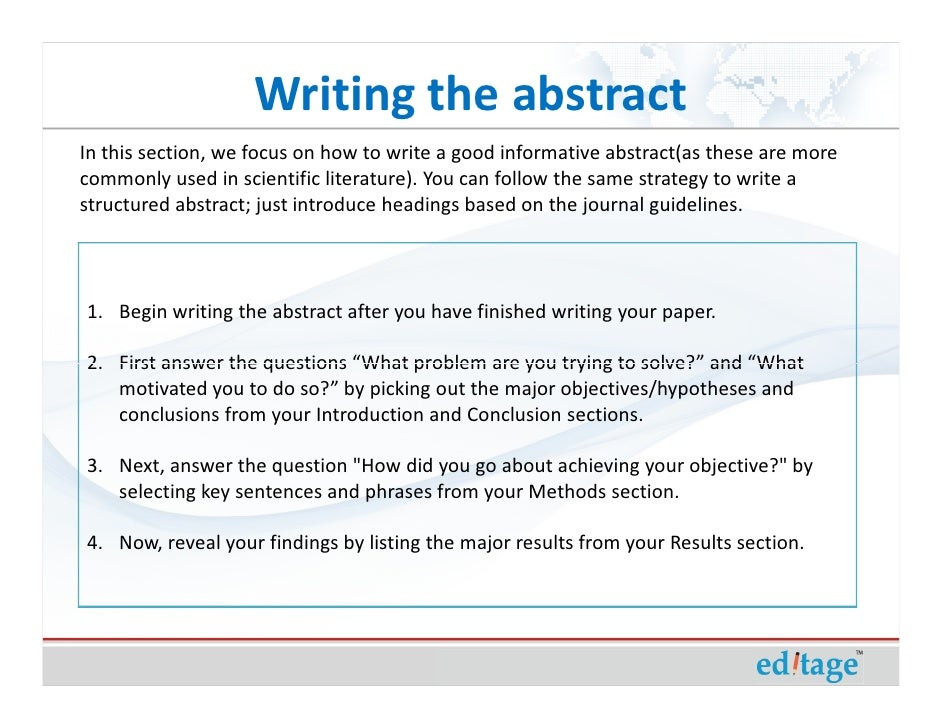
An abstract is a to word paragraph that provides readers with a quick overview of your essay or report and its organization. It should express your thesis (or central idea) and your key points; it should also suggest any implications or applications of the research you discuss in the paper. According to Carole Slade, an abstract is “a · How to write an abstract Here are the basic steps to follow when writing an abstract: Write your paper. Review the requirements. Consider your audience and publication. Determine the type of abstract. Explain the problem. Explain your methods. Describe your results. Give a conclusion. 1. Write your paper Write an article abstract. An abstract is a succinct summary of a larger piece of work that aims to persuade readers to read the full document – essentially, it acts as a shop window, enticing people to step inside. Typically, abstracts are written to accompany a journal research article or book serial chapter, but you are also likely to be asked
How to Write an Abstract | 4 Steps & Examples
Writing an abstract can be difficult because you are tasked with condensing tons of work into such a small amount of space. To make things easier, writing an abstract of an article your abstract last. Read through your entire paper and distill each section down to its main points. Sometimes it can be helpful to answer this question through a subtractive process.
For example, if you are trying to distill down your results, simply list all your findings and then go through that list and start crossing off or consolidating each finding until you are left with a only the most crucial results. Your title and abstract are the primary medium through which interested readers will find your work amidst the deluge of scientific publications, posters, or conference writing an abstract of an article. When a fellow scientist happens upon your abstract they will quickly skim it to determine if it is worth their time to dive into the main body of the paper.
The main purpose of an abstract, therefore, is to contextualize and describe your work in a concise and easily-understood manner. This will ensure that your scientific work is found and read by your intended audience. General and Specific Background ~1 sentence each. Introduce the area of science that you will be speaking about and the state of knowledge in that area.
Start broad in the general background, then narrow in on the relevant topic that will be pursued in the paper.
I f you use jargon, be sure to very briefly define it. Knowledge Gap ~1 sentence. W hat specific question is your work attempting to answer?
Provide a high-level description of your most important methods and results. Implications ~1 sentence. This content was adapted from from an article originally created by the MIT Biological Engineering Communication Lab. Annotated abstract of a microbiology paper published in Nature. Annotated abstract of a paper published in Nature. Home Use The Commkit Journal Article: Abstract Journal Article: Abstract. When to Write the Abstract Results Discussion Introduction Abstract Writing an abstract can be difficult because you are tasked with condensing tons of work into such a small amount of space.
Purpose Your title and abstract are the primary medium through which interested readers will find your work amidst the deluge of scientific publications, posters, writing an abstract of an article, or conference talks. Resources and Annotated Examples. Annotated Example 1 Annotated abstract of a microbiology paper published in Nature. Annotated Example 2 Annotated abstract of a paper published in Nature.
How to Write an Abstract Step-by-Step (With Easy Examples)
, time: 9:20Sample Abstracts for Writing | UNSW Current Students
Write an article abstract. An abstract is a succinct summary of a larger piece of work that aims to persuade readers to read the full document – essentially, it acts as a shop window, enticing people to step inside. Typically, abstracts are written to accompany a journal research article or book serial chapter, but you are also likely to be asked Writing an Abstract Writing Centre Learning Guide Often when asked to write a report or article, you will be required to include an abstract. This is usually a very concise summary of what the report or article is about and is usually placed before the body of your writing. The abstract can File Size: KB Sample Abstracts for Writing. These pages show two examples of typical abstracts from honours theses. Notice that the stages of the abstracts have been labelled, so that you can see the function of each sentence or part-sentence. You can also see that there are differences in the type of information that is included in each abstract, as well as
No comments:
Post a Comment